HIKING HAPPENINGS June 2011
Slickrock Bike Trail – The Practice Loop
article and photos by Marcy Hafner
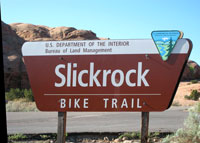 Don't let the name fool you—the Slickrock Bike Trail, which is in the Sand FlatsRecreation Area, is a great place for hikers, too. And sharing this trail with experienced mountain bikers is like watching skilled performers on wheels as the riders twist and turn with stunning speed and grace over the Navajo Sandstone. Don't let the name fool you—the Slickrock Bike Trail, which is in the Sand FlatsRecreation Area, is a great place for hikers, too. And sharing this trail with experienced mountain bikers is like watching skilled performers on wheels as the riders twist and turn with stunning speed and grace over the Navajo Sandstone.
It's hard to imagine that once upon a time—150 to 190 million years ago, towards the end of the Triassic period—nothing but huge sand dunes covered the heart of the Sand Flats Recreation Area. Then a shallow sea invaded the region. When the waters departed, the shifting sands remained—eventually they solidified into the rolling slickrock hills that are a distinctive feature of this area.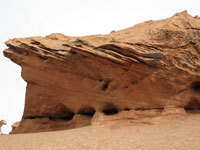
Early settlers invented the word "slickrock" because their metal shod horses found the barren rock slick to walk on. It's just the opposite for hikers and bikers—the sandpaper coarseness provides excellent traction except when it is wet. Then it does get slick!
Former Moab resident Dick Wilson, sometimes referred to as "Mr. Slickrock," formulated the idea of creating a motorcycle trail in Sand Flats. The Bureau Of Land Management (BLM) approved it in May 1969. Then Wilson marked the route, including the practice loop and several spur routes, while naming some of the unique features, such as Abyss Viewpoint, Shrimp Rock and Updraft Arch. The BLM painted the trail with broken white lines and dedicated it on July 22, 1969. Over the years some alterations have been made, but the biggest change occurred in the 1980's when mountain bikers adopted it.
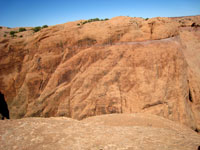 Bordered by two wilderness study areas—Negro Bill to the north, Mill Creek to the south—this unique playground receives almost 100,000 visitors a year. In response to an overload of outdoor recreationists, the Moab community, Americorps, Grand County and the BLM collaborated in 1995 to preserve this spectacular resource—an unusual partnership then formed between the county and the BLM so they could manage, protect, maintain and rehabilitate the 7,320 acres within its boundaries. Bordered by two wilderness study areas—Negro Bill to the north, Mill Creek to the south—this unique playground receives almost 100,000 visitors a year. In response to an overload of outdoor recreationists, the Moab community, Americorps, Grand County and the BLM collaborated in 1995 to preserve this spectacular resource—an unusual partnership then formed between the county and the BLM so they could manage, protect, maintain and rehabilitate the 7,320 acres within its boundaries.
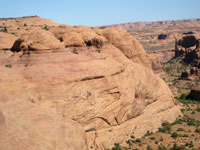 To get there from Main Street, turn east at the Moab Information Center on to Center Street and follow it to the stop sign on 400 East. Then go right, drive five blocks and turn left at Dave's Corner Market on to Mill Creek Drive. At the three-way stop, go straight on the Sand Flats Road up the steep, winding road to the entrance booth. The paved parking area for the Slickrock Bike Trail is on the left a short distance after that. To get there from Main Street, turn east at the Moab Information Center on to Center Street and follow it to the stop sign on 400 East. Then go right, drive five blocks and turn left at Dave's Corner Market on to Mill Creek Drive. At the three-way stop, go straight on the Sand Flats Road up the steep, winding road to the entrance booth. The paved parking area for the Slickrock Bike Trail is on the left a short distance after that.
The big difference between the Slickrock Bike Trail and the Practice Loop is the length. The entirety of the Practice Loop is 1.7 miles—from start to finish the total 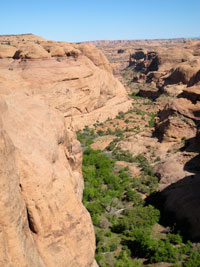 mileage for this hike is 2.3 miles versus 10.5 miles on the main trail. mileage for this hike is 2.3 miles versus 10.5 miles on the main trail.
By following the white lines that start at the east end of the parking lot, you won't get lost. In 3/10ths of a mile, at a distinct crest, it is clearly marked to take a right for the  Practice Loop. Practice Loop.
At the beginning of my walk, I pause and turn full circle for a long look at the familiar geography of my home turf—the Bookcliffs, Moab Rim, Behind The Rocks, Porcupine Rim, the La Sal Mountains—and The Great Wall, a massive rock structure in Arches National Park. Further along, I occasionally catch a glimpse of the winding gap of Negro Bill Canyon, and at one particular high point I can even peek down its lengthy corridor all the way to the Colorado River!
After the chilliness of April, the wildflowers—cliffrose, wallflower, sand verbena and evening primrose- are finally responding to the wake up call of a late spring. The creamy-white, uniquely designed petals of the evening primrose are pollinated by nocturnal insects, so it makes sense that those blossoms open up to them during the coolness of early evening and close during the heat of the day.
Each half-mile on the Practice Loop is marked with a blue dot. A short distance after the first half-mile marker, I choose the option to take the side trail for the view at Echo Point. On this short trail, it doesn't take long before the white lines turn to yellow with the warning: "Foot Trail." A little further, a mass of yellow dots marks the obvious end of the trail.
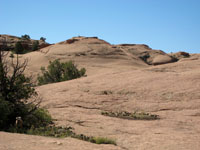 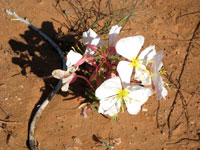 And what a view it is on this warm, seductive day in early May. Looking down on the lush bottom of Echo Canyon, a side canyon of Negro Bill—the swirling layers and scalloped edges of the rounded canyon walls remind me of a lopsided, multi layered birthday cake. Beyond the canyon walls, I am surrounded by the undulating rhythm of the rich red-brown sandstone. Depressions within the slickrock, which are filled with wind- blown soil, have created a wonderful surprise—mini gardens where Mormon tea, prickly pear, yucca, pinyon pines, junipers and scrub oak thrive. And what a view it is on this warm, seductive day in early May. Looking down on the lush bottom of Echo Canyon, a side canyon of Negro Bill—the swirling layers and scalloped edges of the rounded canyon walls remind me of a lopsided, multi layered birthday cake. Beyond the canyon walls, I am surrounded by the undulating rhythm of the rich red-brown sandstone. Depressions within the slickrock, which are filled with wind- blown soil, have created a wonderful surprise—mini gardens where Mormon tea, prickly pear, yucca, pinyon pines, junipers and scrub oak thrive.
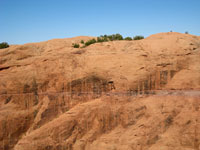 As I listen to a pair of mourning doves soothingly coo their melancholy song, I watch a red-tailed hawk and some turkey vultures gain altitude by hitchhiking a ride on the rising thermals. Effortlessly they circle ever higher in a powdery blue sky, a sharp contrast to the speed-demon antics of the white-throated swifts that whiz in and out of the canyon—one of the fastest birds in North America, they can dive off cliffs at speeds up to 200 mph. As I listen to a pair of mourning doves soothingly coo their melancholy song, I watch a red-tailed hawk and some turkey vultures gain altitude by hitchhiking a ride on the rising thermals. Effortlessly they circle ever higher in a powdery blue sky, a sharp contrast to the speed-demon antics of the white-throated swifts that whiz in and out of the canyon—one of the fastest birds in North America, they can dive off cliffs at speeds up to 200 mph.
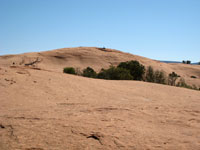 After a long refreshing break, I'm back on the Practice Loop, and the next blue dot marker indicates that I've covered the distance of one mile. After that, several sand pits, which drag at my feet, bring most mountain bikes to a frustrating halt! The last 1.5 mile blue dot comes up just before returning to the main trail, where it is clearly marked on the slickrock—left to return to the parking lot, or right to continue further on. After a long refreshing break, I'm back on the Practice Loop, and the next blue dot marker indicates that I've covered the distance of one mile. After that, several sand pits, which drag at my feet, bring most mountain bikes to a frustrating halt! The last 1.5 mile blue dot comes up just before returning to the main trail, where it is clearly marked on the slickrock—left to return to the parking lot, or right to continue further on.
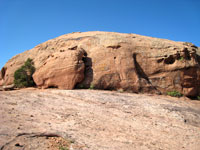 A quick ten-minute drive out of town makes this highly accessible, year round treasure ideal for short, spontaneous outings. It is most crowded in the spring, but it's also popular in the fall when weather conditions are usually at their optimum. What a difference the solitude of winter makes, when the trail often disappears under a bed of snow—a tremendous contrast to the other extreme, when summer temperatures often rise above the century mark. Then it's a recipe for a blazing workout in a land of minimal shade where the heat radiates off the slickrock walls like a convection oven. At that time of year start very early (the crack of dawn) or very late in the afternoon and be sure to carry a huge supply of water!! A quick ten-minute drive out of town makes this highly accessible, year round treasure ideal for short, spontaneous outings. It is most crowded in the spring, but it's also popular in the fall when weather conditions are usually at their optimum. What a difference the solitude of winter makes, when the trail often disappears under a bed of snow—a tremendous contrast to the other extreme, when summer temperatures often rise above the century mark. Then it's a recipe for a blazing workout in a land of minimal shade where the heat radiates off the slickrock walls like a convection oven. At that time of year start very early (the crack of dawn) or very late in the afternoon and be sure to carry a huge supply of water!!
|
Biological Soil Crust (aka)
Cryptos (krip’ tose):
The surface of
Moab’s desert is held
together by a thin skin of living organisms known as cryptobiotic
soil or cryptos. It has a lumpy black appearance, is very
fragile, and takes decades to heal when it has been damaged.
This soil is a critical part of the survival of the desert.
The cryptobiotic organisms help to stabilize the soil, hold
moisture, and provide protection for germination of the seeds
of other plants. Without it the dry areas of the west would
be much different. Although some disturbance is normal and
helps the soil to capture moisture, excessive disturbance
by hooves, bicycle tires and hiking boots has been shown
to destroy the cryptobiotic organisms and their contribution
to the soil. When you walk around Moab avoid crushing the
cryptos. Stay on trails, walk in washes, hop from stone to
stone. Whatever it takes, don’t crunch the cryptos
unless you absolutely have to! |

Cryptobiotic soil garden
|
|
|